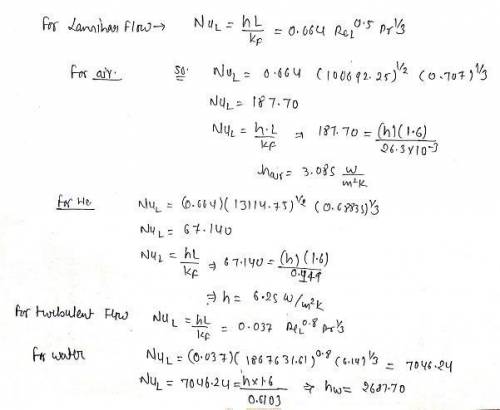
Engineering, 25.02.2020 03:26 marchellepenuliar
Iven & Find: Compare the average heat transfer coefficients for three different fluids. In all cases the length of the plate is 1.6 m and the freestream velocity is 1 m/s moving parallel to the plate. Evaluate fluid properties at P = 1 atm and T = 300K. Each of the cases involves a different fluid
i) air,
ii) helium, and
iii) water. Fill in the table of properties for each of the fluids as you will need them in the calculations. Comment on the results.

Answers: 3


Another question on Engineering

Engineering, 03.07.2019 14:10
Explain the difference laminar and turbulent flow. explain it with the shear stress and the velocity profiles.
Answers: 1

Engineering, 04.07.2019 18:10
Aloaded platform of total mass 500 kg is supported by a dashpot and by a set of springs of effective stiffness 72 kn/m. it is observed that when the platform is depressed through a distance x = 12.5 cm below its equilibrium position and then released without any initial velocity; it reaches its equilibrium position in the shortest possible time without overshoot. find the position and velocity of the loaded platform 0.10 sec. after its release. if a further load of 400 kg is added to the platform, find, i) the frequency of damped vibrations, and i) the amplitude of vibration after 2 complete oscillations, given that the initial amplitude is 15 cm.
Answers: 1

Engineering, 04.07.2019 18:10
If a particle moves along a path such that r : (3 sin t) m and ? : 2t rad, where t is in seconds. what is the particle's acceleration in m/s in 4 seconds? a)- 16.43 b)- 16.29 c)- 15.21 d)- 13.79
Answers: 1

Engineering, 04.07.2019 18:10
Thermal stresses are developed in a metal when its a) initial temperature is changed b) final temperature is changed c) density is changed d) thermal deformation is prevented e) expansion is prevented f) contraction is prevented
Answers: 2
You know the right answer?
Iven & Find: Compare the average heat transfer coefficients for three different fluids. In all c...
Questions


























